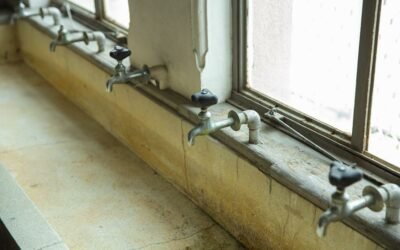Do you ever wonder if your favorite bag of chips can grow mold? Well, the answer might surprise you.
In this article, we will explore the fascinating process of mold growth on chips. Discover the factors that contribute to mold growth, the different types of mold that can be found on chips, and the telltale signs of moldy chips.
Plus, we'll provide you with valuable tips to prevent your beloved snacks from becoming victims of mold.
Key Takeaways
- Mold can grow on any surface with moisture and organic matter.
- Moisture is crucial for mold growth on chips.
- Proper ventilation and airflow help prevent mold growth on chips.
- Consuming moldy chips can lead to foodborne illnesses or allergic reactions.
Understanding the Mold Growth Process
If you want to understand the mold growth process, you should start by knowing that it can happen on any surface where moisture and organic matter are present. Mold is a type of fungus that thrives in damp environments and feeds on organic materials such as wood, paper, and fabric. When these conditions are met, mold spores, which are tiny reproductive cells, can settle and begin to grow.
The first step in the mold growth process is the introduction of moisture. This can occur from a leaky pipe, a roof leak, or even high humidity levels. Once moisture is present, the organic matter provides the necessary nutrients for mold to thrive. Mold spores, which are constantly present in the air, will land on the damp surface and begin to germinate.
As the spores germinate, they start to form hyphae, which are thread-like structures that spread and penetrate the organic matter. These hyphae release enzymes that break down the organic material, allowing the mold to absorb the nutrients. As the mold continues to grow, it produces more spores that can be released into the air, causing potential health risks.
Factors Affecting Chip Mold Growth
To understand the factors affecting chip mold growth, consider the conditions in which mold spores can settle and thrive on the surface of chips. Mold growth occurs when certain factors align, creating an optimal environment for spores to multiply.
Here are three key factors that contribute to chip mold growth:
- Moisture: Mold thrives in damp environments, making moisture a crucial factor for mold growth on chips. If chips are exposed to humidity or stored in a moist environment, it creates a favorable condition for mold spores to settle and flourish.
- Temperature: Mold spores require a specific temperature range to grow. The ideal temperature for mold growth on chips is between 77-86°F (25-30°C). If chips are stored in an environment with temperatures within this range, it significantly increases the likelihood of mold growth.
- Airflow: Proper ventilation plays a significant role in preventing mold growth on chips. Stagnant air increases moisture buildup, creating an environment conducive to mold growth. Adequate airflow helps to reduce humidity levels and minimize the chances of mold spores settling on the surface of chips.
Common Types of Mold Found on Chips
You may encounter various types of mold on chips, including common strains like Aspergillus and Penicillium. These molds can grow on chips that have been exposed to moisture, warm temperatures, and air for an extended period. Here are three common types of mold that you might find on your chips:
| Mold Type | Appearance | Characteristics |
|---|---|---|
| Aspergillus | Fuzzy green | Thrives in warm and humid environments. Can produce mycotoxins which may cause allergic reactions. |
| Penicillium | Blue or green | Grows rapidly and thrives in cooler temperatures. Can produce mycotoxins and contribute to food spoilage. |
| Cladosporium | Olive-green or brown | Commonly found in indoor environments. Can cause respiratory issues in sensitive individuals. |
It is important to note that not all molds are harmful, but consuming moldy chips can lead to foodborne illnesses or allergic reactions in some individuals. To prevent mold growth, store chips in a cool, dry place and ensure the packaging is airtight. If you notice any mold on your chips, it is best to discard them to avoid potential health risks.
Signs and Symptoms of Moldy Chips
One common sign of moldy chips is the presence of visible mold growth on the surface. Mold can appear as fuzzy, discolored patches that range in color from white to green, blue, or black. This is a clear indication that the chips have been contaminated and shouldn't be consumed.
Additionally, moldy chips may emit a musty or unpleasant odor. If you notice a strange smell coming from your bag of chips, it's a good idea to inspect them for mold.
Another sign to look out for is a change in texture. Mold can cause the chips to become soft or soggy, making them unappetizing and potentially unsafe to eat.
It's important to be vigilant and check your chips before consuming them to avoid any potential health risks associated with mold contamination. Remember, when in doubt, it's best to err on the side of caution and discard any moldy chips to protect your health.
Tips for Preventing Chip Mold Growth
Preventing chip mold growth can be achieved by properly storing and sealing your chips. Mold thrives in warm and moist environments, so it's important to keep your chips in a cool and dry place. Make sure to store them in an airtight container or resealable bag to prevent moisture from getting in. Additionally, avoid exposing your chips to direct sunlight or heat sources, as this can create a breeding ground for mold.
Regularly check the expiration date on your chip bags and consume them before they expire. Mold spores can contaminate the chips during the manufacturing process, and the longer they sit on the shelf, the higher the chances of mold growth. When purchasing chips, inspect the packaging for any signs of damage or tampering, as this could indicate potential mold growth.
If you notice any moldy chips in your stash, discard them immediately. Mold can spread quickly, so it's important to remove any contaminated chips to prevent further growth. It's also advisable to clean the storage containers or bags regularly to eliminate any potential mold spores.
Conclusion
In conclusion, understanding the mold growth process is crucial in preventing mold on chips. Factors such as moisture, temperature, and air quality can affect mold growth.
Common types of mold found on chips include Aspergillus and Penicillium. Signs of moldy chips include discoloration, strange odors, and a fuzzy texture.
To prevent chip mold growth, store chips in a cool, dry place, seal bags tightly, and consume them before the expiration date.






0 Comments